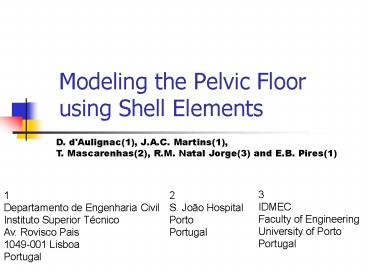Modeling the Pelvic Floor using Shell Elements PowerPoint PPT Presentation
Title: Modeling the Pelvic Floor using Shell Elements
1
Modeling the Pelvic Floor using Shell Elements
D. d'Aulignac(1), J.A.C. Martins(1), T.
Mascarenhas(2), R.M. Natal Jorge(3) and E.B.
Pires(1)
3IDMECFaculty of EngineeringUniversity of
Porto Portugal
1Departamento de Engenharia Civil Instituto
Superior Técnico Av. Rovisco Pais 1049-001
Lisboa Portugal
2S. João HospitalPortoPortugal
2
Plan
Finite Element Simulation
Anatomy
Data
Geometry
3
Why?
- Understand working of the pelvic floor
- Support of organs
- Predict damages during childbirth
- Stress incontinence
- Prolapse
- Uterine
- Vaginal
- Rectal
4
Pelvic Floor
Illust. From Netter
5
MRI Images
Sao Joao Hospital, Porto
axial
sagittal
6
Visualisation
- Segmented manually from MRI data. Julia R.
Fielding et al. (Harvard medical school)
Rasmussen et al (University of Illinois at
Chicago)
7
Cadaver Measurements
Janda et al 2003
8
Geometry
Point Set
NURB Surfaces (Rhino 3d)
Polygon Mesh
9
Mesh Geometry
top
Frontal view of the mesh 3068 triangles 1620
nodes
side
10
3D Muscle Model
Martins et al. 98
isotropic
fibers
volume
11
Muscle Model
Deformation gradient
Left Cauchy-Green tensor
Right Cauchy-Green tensor
12
Muscle Model
First Invariant
Fibre strain
Direction of fibres (deformed)
13
Plane Stress
Since incompressibility is assumed
Since normal stresses are zero the plane stress
is given as
14
Passive Behaviour
isotropic
fibres
Humphreys model for cardiac tissue
15
Passive Tests
u
lambda
16
Muscle Fibres
17
Active Behaviour
18
Muscle Activation
Sum of passive and active contributions
19
Total Stress
isotropic
total
active
fibers
20
Discussion
- Large quantitative differences between different
models - Oomens
- Martins
- Bosboom
- Gielen
- Kojic
- Humphrey
- Comparison with other models and experimental
results is essential
21
Simulation
3068 triangular shell elements Non-linear
simulation performed with ABAQUS UMAT routine
decribing the material
22
Muscle Activation
23
The Future
- Deformation of pelvic floor during childbirth
- Damage, fracture of soft tissues
- Prolapse of internal organs
- Geometric models from MRI data
- 8-node solid FE (de Sousa et al. 03)
24
Muscle Model
Deformation gradient
Left Cauchy-Green tensor
Right Cauchy-Green tensor
PowerShow.com is a leading presentation sharing website. It has millions of presentations already uploaded and available with 1,000s more being uploaded by its users every day. Whatever your area of interest, here you’ll be able to find and view presentations you’ll love and possibly download. And, best of all, it is completely free and easy to use.
You might even have a presentation you’d like to share with others. If so, just upload it to PowerShow.com. We’ll convert it to an HTML5 slideshow that includes all the media types you’ve already added: audio, video, music, pictures, animations and transition effects. Then you can share it with your target audience as well as PowerShow.com’s millions of monthly visitors. And, again, it’s all free.
About the Developers
PowerShow.com is brought to you by CrystalGraphics, the award-winning developer and market-leading publisher of rich-media enhancement products for presentations. Our product offerings include millions of PowerPoint templates, diagrams, animated 3D characters and more.

